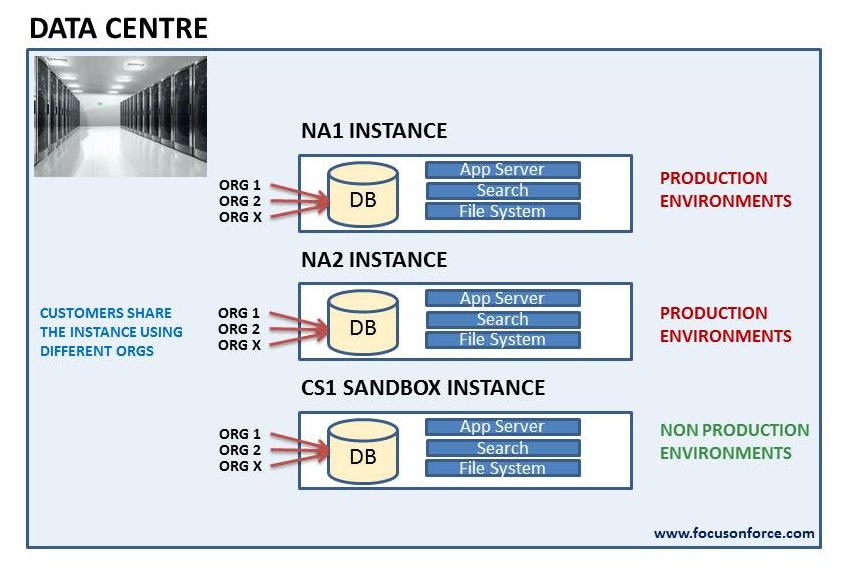Once you start getting involved with Salesforce, you will hear a number of terms such as Instance, Org, Environment and even POD. Its easy to get these confused or even not to even be aware of what they really mean. One person may refer to the development instance and another the development environment. Some organisations may refer to the fact that they have multiple instances of Salesforce, and another multiple orgs. Here is a quick guide to the Salesforce terminology.
To understand the Salesforce terminology, you must first understand the multi-tenancy concept. Salesforce uses a multi-tenancy architecture, meaning that a number of customers share IT resources such as database servers, application servers and infrastructure required to run applications, resulting in an environment that can be standardised and optimised for all efficiently and a lower cost for each 'tenant' as the resources are managed centrally.
Salesforce Instance or POD
Salesforce groups together around 10,000 customers together into what it calls a Point of Deployment or POD. A POD is also known as an Instance and it is a self contained unit that contains all that is required to run Salesforce, including the application server, database server, database itself, search and file system. Each customer is allocated to one and only POD and that is where their data resides. As of July 2014, there are currently 21 Instances in North America, 2 in Asia Pacific, 4 in EMEA and 25 Sandbox Instances. A Sandbox instance is non production environment.
The complete list of Salesforce instances and the current status of each one is listed at Salesforce Trust.
Below is a list of some of the North American Instances. You can see that each instance can have a different status. All of the instances except for NA1 have an informational message. Informational messages can be used to inform customers of an upgrade to a new release is starting or has completed. On July 11 there was a performance issue with NA0, but this did not affect any of the other instances shown.

To determine which instance you are using, check the URL after you login into Salesforce. In the example below, the customer is on the ap1 instance.
In the case of a Sandbox, the URL will be one of the cs instances such as cs6 in the case below.
In maybe that you don't see the instance in the URL if you are using a custom domain, in that case the URL will be something like: https://xxx.my.salesforce.com/home/home.jsp, where xxx is your company name. Salesforce offers a lookup service from the trust site, for you to enter your custom domain and it will return the instance it is using.
Salesforce Org
Now we understand what an Instance or POD is, what is a Salesforce Org or Organisation? An org is an identifier that represents a customers version of Salesforce and its data within an instance. Each org can be highly customised including custom fields, custom objects, workflows, data sharing rules, visualforce pages and apex coding. You can find your own org id in the Company Information page within Salesforce.
If you request to enable a feature such as person accounts, territory management or multi-currency, Salesforce will request your org id, so that it can enable the feature just for your org.
As all customers within an instance are sharing the same database, the org id is stored in every table to ensure that every row of data is linked back to the correct customer and the data from other customers sharing the same instance cannot be mixed up.
Salesforce Environments
So, finally what are Salesforce environments? An environment is a Salesforce org that is used for a specific purpose. Salesforce customers will have an org that is used as their production or 'live' environment. They will also usually have additional orgs used for development, testing, integration or training purposes, and these are referred to as development environments, testing environments etc. Non production orgs will be housed in one of the Sandbox instances.
Salesforce Data Centre, Instances, Orgs and Environments
The diagram below pulls everything together that has been explained so far. Salesforce has a number of data centres around the world. In each datacentre are a number of instances. Each instance will support around 10,000 customers each with their own Salesforce org. The org will be used as a production environment, unless it is housed on a Sandbox instance, in which case the org will be used for development, testing, integration testing, training or another non production purpose.

What Certification are you studying for now?
Focus on Force currently provides practice exams and study guides for sixteen certifications






